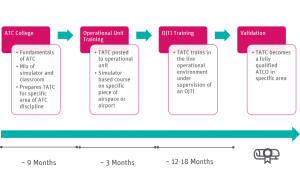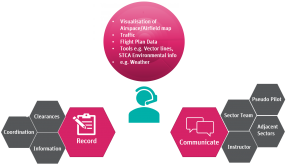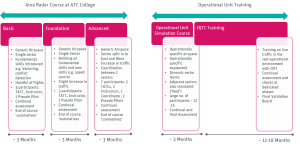…Thoughts from a former trainee ATCO
On the 18th June I attended a Webinar entitled ‘Leading the way: Virtual Training for ATCOs’, of which our Manging Director, Conor Mullan, participated along with Greg Pile, MD from Micro Nav, Sharon Cooke from Airways International NZ and Waleed Al Riyami, Air Traffic Services Inspector from GCAA . Conor is also due to sit on the panel for another Webinar on the 11th August – ‘The Role of Remote Towers in future Air Traffic Management’ which will discuss various topics including how to simulate and train staff to be ready during a pandemic.
The June webinar discussed the future of ATCO training and explored how virtual training opportunities can be of benefit now and for the future, how we can use innovation to remove barriers to learning in a remote environment and how to overcome regulation hurdles surrounding remote certification. Remote learning is a concept that has been a technical possibility for a number of years, however it has become a particular area of focus in light of the current COVID-19 situation where simulation rooms have sat empty and ATCO training placed on hold.
Since the lockdown began back in March, Think have already been involved in remote real time simulations (RTS) that were conducted in a different country, where the simulation exercises were filmed and broadcast live via Teams to those involved. See our recent thoughts on developing the remote RTS capability here. If remote RTSs are possible, then why not ATCO training programmes too? As a former trainee air traffic controller (TATC) I would like to share my perspective and thoughts on the issue of virtual ATCO training, having gone through various stages of the NATS Trainee ATC programme from 2008-2010.
Training Types
An ATCO shall be required to undertake various forms of training during their career, beginning with Ab-initio training which contains several stages that are required to be completed before becoming a fully qualified ‘valid’ controller:

Once validated, an ATCO will be required to undertake the following:
- TRUCE (Training for Unusual Circumstances and Emergencies).
A valid ATCO is required to undertake TRUCE annually. This is conducted in a simulated environment whereby the ATCO can practice scenarios such as aircraft emergencies and failure of equipment.
- Training for new procedures, airspace change and implementation of new technologies
ATCOs may also be required to take part in simulations where new procedures, airspace change or new systems and technologies are being tested prior to implementation.
- Annual recency/competency checks.
A valid ATCO is required to be assessed annually to keep their licence current. This is conducted ‘on-the-job’ (OJT) in the operational environment. A verbal examination is conducted on the operational unit and on the sector-specific rules and regulations. An ATCO is also required to conduct a minimum number of controlling hours per month, and if they are unable to achieve this minimum for reasons such as illness, then they must undergo some supervised sessions by an OJTI when returning to work.
- Cross Validation
An ATCO may undergo training to become validated on another sector of airspace or position. This is also conducted OJT.
Analysis of Training Requirements
Training can be split into 3 distinct categories, whether it be for an Ab-initio or valid ATCO – Classroom, Simulation and OJT. OJT is basically what it says on the tin and must be done in a real-life operational environment. This is because no matter how realistic a simulator, there is no comparison between the experience of doing real life ATC and simulated ATC. Therefore, there seems little point in discussing here the possible merits of OJT training being replaced a) by simulator training and b) being conducted remotely on a virtual platform. Not to mention the massive hurdles and complexities that would occur if trying to gain regulatory approval for this kind of change.
However, let us consider the remaining 2 categories – classroom-based learning and simulation, and explore the different technical and human requirements that are necessary for each:
Classroom Based Learning
Back when I was a TATC all ‘bookwork’ subjects were taught at the ATC college, by an instructor in a classroom. This aspect of the course could easily be conducted via a virtual platform such as Teams or Zoom. If the current COVID pandemic has taught us anything, it is that all kinds of learning can be conducted online, and successfully so. The learning could be based upon a flexible self-taught basis, whereby the TATC works at their own pace, or a more structured timetable with an instructor leading an interactive ‘live’ session. This type of learning is a method already employed by Airways International through the use of their interactive eBooks Airways AirBooks.
From a technical perspective the ATCO must be in possession of a device that allows them to participate in all virtual learning sessions.
The benefits include a reduction in cost for the ANSP of fixed assets such as classroom space, as the training can be conducted regardless of instructor and TATC location. For the TATC, they will not have the associated costs of travelling to the ATC college and accommodation nearby if required.
However, the downside of remote classroom learning is the loss of human and social interaction and the immersive learning experience for the TATCs on such a course. As was discussed during the Webinar, the instructors would need to be taught different methods of being able to engage the TATC and deliver remote training effectively to minimise this risk.
TATC’s are required to undertake regular written and verbal examinations (ask any ATCO about the dreaded Oral Board!) to be tested on rules, regulations, procedures, and theoretical knowledge. Consideration would need to be given to if these examinations could also be conducted virtually in a secure and controlled assessment environment and the necessary regulatory approval is gained.
Simulation
Moving on to the practical aspect of ATCO training – the simulator. Most ANSPs and Airports will own their own ‘in-house’ simulation facility, consisting of physical pieces of hardware and equipment, and all simulator participants must be physically present to participate.
The premise behind a virtual simulation capability is that the technology is cloud-based and the software can be run up on any number of devices. As Greg Pile explains, all that is needed by the participant is ‘glass’ and an internet connection. This technology already exists, for example, Micro Nav’s ‘BEST Remote’ or EUROCONTROL’s ‘ESCAPE Mobile’ simulator capability. One of the main benefits of such a solution is to allow training to be conducted without the need for the ATCO, instructor, and pseudo-pilot to be at the same location. This can be particularly useful for situations whereby the ATCOs are required to travel to an ATC training facility that is located in a different country. To explore this concept, I shall firstly outline both the technical and human requirements of a simulation:
TECHNICAL:

- The ATCO requires an interface in which they can view the specific sections of airspace/airfield that they require, in addition to other essential tools and information – e.g. telephone panel, electronic flight strips, coordination information, conflict detection tools etc.
- The ATCO is required to communicate with:
- pseudo-pilots;
- Instructor;
- other members of their sector team and adjacent sectors where applicable;
- The ATCO needs to be able to control the simulated traffic in a representative manner as they would in the real world – e.g. record clearances instructions, record coordinations, and interrogate various sources of information.
HUMAN:
Consideration must be given to ensure that the human aspect of the ATCO role is taken into account. Let’s examine the following factors that are important in the simulation experience:
- Teamwork: The interaction between the ATCO and their sector team members (e.g. Tactical and Planner) is a vital aspect of the simulation experience. Often team members are sat next to one another, allowing them to converse freely. They may lean across and point to one another’s screens and discuss tactical and coordination plans.
- Realism: The simulator environment is important for preparing the trainee for OJT training in the live operational environment. During my operational unit training at Swanwick, the simulator workstation consisted of the exact equipment that I would go onto use during OJT.
- Instructor/TATC Relationship: The interaction between the Instructor and their TATC is an important one and is far greater than the Instructor simply being able to see the radar screen and listen to the instructions that the TATC is issuing. The Instructor when sat directly at the workstation can pick up many cues – the TATC’s body language, their level of stress, and are able to observe how the TATC is interrogating the flight information and discuss with the TATC their thinking about different traffic scenarios .
- Debrief: After a simulation run is conducted the debrief process is an important part of the exercise, where the exercise is dissected and discussed between TATC and Instructor.
- Assessment: As well as assessments at the end of a dedicated phase of training, the Instructor is continually assessing the TATC, and will write a report at the end of each exercise. The TATC is assessed on various areas such as Safety, R/T, Coordination and forward planning. They will be assessing if the TATC fulfils these areas ‘Fully’, ‘Mostly’, ‘Partly’ or ‘Not Achieved’. These reports are collated in a training file, in which the TATCs progress over time can be monitored and any reoccurring issues can be identified.
A Simple Switch From Real Life To Virtual?
Taking into consideration the technical and human requirements of a simulation, can we conclude that, providing all these requirements are met, we can then transfer any simulation activity to a virtual platform? Drawing on my knowledge and experience of going through the TATC training process through to the OJT stage, I would suggest that there are certain stages of TATC training that could be well suited to a virtual platform, and this is dependent on certain factors, such as the complexity of the simulation design and the number of participants and interaction between them. The diagram below illustrates the different stages of simulation training that I experienced during the Area Radar Course:

During the Basic and Foundation ATC college Radar course, the simulation is based on a simple generic airspace sector, in which the fundamental air traffic skills can be introduced. I remember well, how during my first few simulator exercises only having 1 or 2 aircraft on frequency at a time! The exercises build up slowly, allowing ample time for instruction by the instructor. The simplicity of the simulation therefore negates the need for replicating any advanced kind of controller support tools at this stage, and additionally because it is not yet known to which operational unit the TATC will be posted, it is not required that the simulator replicates a specific operational environment. In the Basic and Foundation stages only 3 people are participating per exercise (TATC, instructor and Pseudo pilot) therefore only 2 communication channels are required: Instructor – TATC and TATC – Pseudo pilot. Based on these reasons, I would therefore suggest that these first 2 stages of the course could be suitable contenders to be conducted virtually, provided that the lack of face to face interaction between the instructor and TATC was not at a detriment to the learning experience.
Moving on to the advanced course, the complexity of the airspace and number of participants increases from 3 to 7 and communication and coordination between sectors is introduced. Communication channels need to be facilitated between Instructor – TATC, TATC – TATC, TATC – Pseudo pilot and TATC – Coordinator. These simulation exercise teach the TATC the importance of teamwork and how it is vital to ensuring the efficient flow of traffic. If these advanced simulations were also to be delivered virtually, the platform needs to be capable of supporting the communication and interaction between all participants, again ensuring that the loss of human interaction is mitigated for.
Once the TATC is posted to their operational unit, they then begin to train on larger scale simulations, using technical equipment representative of the operational environment. The simulations will teach the TATC not only about the air traffic within their designated sectors but will be trained how to use specific pieces of equipment e.g. electronic flight strips and controller support tools. Again, the interaction and communication between adjacent sectors is a vital part of the simulation, and in addition, events such as bandboxing and splitting will be regularly practiced. For these reasons I would argue that to try and replicate this virtually could be a challenge. This argument also applies to the annual TRUCE training, as scenarios such as equipment failure are simulated as well as emergency scenarios.
One human aspect of the training simulation that was listed earlier is the issue of assessment. Careful consideration should be given as to how an instructor is able to properly assess the TATC in a virtual environment. Is the instructor able to adequately assess each area of focus e.g. Safety – can the instructor easily pick up unsafe clearances and follow the plan that the TATC is implementing? Is the instructor able to get a good sense of the comfort level of the TATC during the exercise just from hearing their voice, rather than taking cues from body language if they were sat right next to them. The TATCs performance is required to be recorded – in my day it was written on a piece of paper and put into a ring binder; in the virtual world, these reports would need to be recorded electronically, which I believe is a process that has already been introduced in some ANSPs. And once again, the required regulatory approval of assessing remotely would need to be considered.
When considering simulations that are conducted to test out changes to airspace, procedures or concept development, a virtual set up may be suitable, depending on how complex the simulator design is. It has been suggested that one way to take advantage of the number of furloughed ATCOs during the COVID period is to utilise them in the simulator by getting involved in various concept development projects (see another Think blog here exploring this in further detail). If the ability was there to do this remotely, this would be a benefit as it would negate the need to consider the conduct of the simulator around current social distancing rules.
Regulation and Culture Shift
During the Webinar it was also discussed how the COVID pandemic has brought about a significant culture shift. This unprecedented situation has forced us as an industry to consider how things can be done differently and allowed us to be open minded to change. Even now, where the situation is slowly beginning to recover and we can look towards things going back to some kind of normality, it does not necessarily mean that things have to go back to being exactly the same as they were before. We can take advantage of the lessons that have been learnt and apply them to the future. To quote Sharon Cooke: “Never waste a crisis”.
Conclusion
To conclude; although it may be possible for ATC training to be conducted virtually, does this mean that it should? As I have explored, there are certain stages of training that are suitable candidates to be conducted via a virtual platform, namely the classroom-based stage of the ATC college course and the first stage of simulations as a starting point, provided the issues I have raised can be mitigated for. Indeed, there are some ANSPs that are already employing some virtual training methods, such as Airways International NZ.
Towards the end of the session, a poll was conducted. The following question was put to the 116 participants:
To what extent could virtual training replace local classroom and simulator training for ATCOS?
-
- a) Not at all. ATCOs should always have face to face training;
- b) A little. A blended approach using both techniques;
- c) Quite a lot. Simulation can offer the same experience;
- d) Virtual can replace classroom and simulation.
51 % of the respondents, including myself answered b). Only a minority felt that either it should be a) 5% or d) 8% and 36% answered c). I feel that there will be many changes occurring in the ATCO training process going forward, and that remote and virtual training methods will become more prevalent as time goes on. If this blog post has grabbed your attention and there is anything you would like to know more about, or discuss with us then please get in touch: +44 (0)1202 765654 or email us at: info@think.aero

Author: Sarah Cavanagh, ATM Consultant


Recent Comments